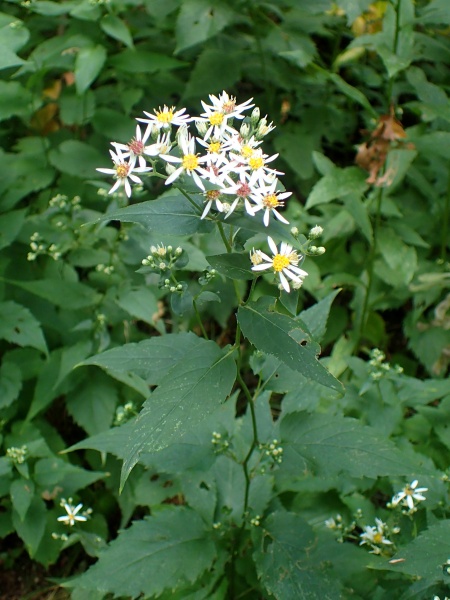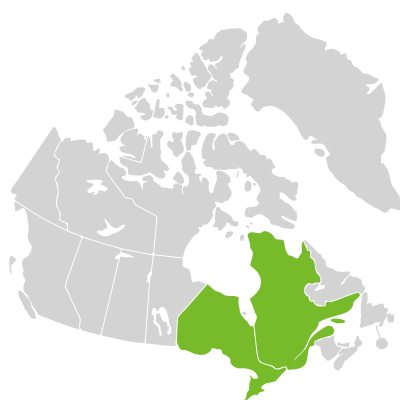
Source: Krzysztof Ziarnek
Eurybia divaricata
White Wood Aster
Aster à rameaux étalés
Synonyms
white heart-leaved aster
aster divariqué
Seeds in stock
Available at table Shade
Available at table Shade
We currently accept seeds for this plant
Bloom Colour: White
Bloom Period: Aug - Nov
Max Height: 2.0 feet
Max Width: 3.0 feet (spreads by rhizome)
Light Condition:
 More than 2 or 3 hours but less than 6 hours of direct sun a day
Soil conditions:
More than 2 or 3 hours but less than 6 hours of direct sun a day
Soil conditions:
 Tolerates medium soil condition
Tolerates medium soil condition
 More than 2 or 3 hours but less than 6 hours of direct sun a day
More than 2 or 3 hours but less than 6 hours of direct sun a day
 Tolerates medium soil condition
Tolerates medium soil condition
Lifespan:
Perennial
plants that will that come back year after year
Gardener Experience:
 Suitable for beginner gardeners
Suitable for beginner gardeners
 Does not spread uncontrollably
Does not spread uncontrollably
 Easy to germinate
Easy to germinate
 Suitable for beginner gardeners
Suitable for beginner gardeners
 Does not spread uncontrollably
Does not spread uncontrollably
 Easy to germinate
Easy to germinate
Landscape Uses:
 Suitable for Right of Way gardens
Suitable for Right of Way gardens
 Suitable for container garden
Suitable for container garden
 Suitable for school gardens
Suitable for school gardens
 Tolerates boulevard garden conditions
Tolerates boulevard garden conditions
 Suitable for Right of Way gardens
Suitable for Right of Way gardens
 Suitable for container garden
Suitable for container garden
 Suitable for school gardens
Suitable for school gardens
 Tolerates boulevard garden conditions
Tolerates boulevard garden conditions
Ecological Benefits:
 Supports pollinators
Supports pollinators
 Butterfly host
Butterfly host
 Keystone species
Keystone species
 Supports pollinators
Supports pollinators
 Butterfly host
Butterfly host
 Keystone species
Keystone species
Tolerates:
 Tolerates salt conditions
Tolerates salt conditions
 Tolerates limestone conditions
Tolerates limestone conditions
 Tolerates sandy conditions
Tolerates sandy conditions
 Tolerates juglone conditions
Tolerates juglone conditions
 Tolerates salt conditions
Tolerates salt conditions
 Tolerates limestone conditions
Tolerates limestone conditions
 Tolerates sandy conditions
Tolerates sandy conditions
 Tolerates juglone conditions
Tolerates juglone conditions
Special Features and Considerations:
 This plant is endangered
This plant is endangered
 This plant is endangered
This plant is endangered
Plant Location
Distribution according to VASCAN

Ephemeral
Native
Introduced
Excluded
Extirpated
Doubtful
Absent
Thrives in Ecozones
- Atlantic Maritime
- Mixed Wood Plains
Ecological Benefits
Butterflies Supported by Eurybia divaricata
No butterfly data available for this plant.
Specialized Bees Supported by Eurybia divaricata
- Andrena asteris
- Andrena canadensis
- Andrena placata
- Andrena simplex
- Melissodes druriellus
Plants that grow in similar conditions, that bloom at the same time.
Complementary Plants
- Lobelia inflata
Inflated Tobacco
Lobélie gonflée - Muhlenbergia mexicana
Mexican Muhly
Muhlenbergie du Mexique - Scrophularia marilandica
Eastern/carpenter's Figwort
Scrofulaire du Maryland - Solidago flexicaulis
Zigzag Goldenrod
Verge d'or à tige zigzagante - Symphyotrichum cordifolium
Heart-leaved Aster
Aster à feuilles cordées
Substitute For Non-Native Plants
- Ajuga reptans (Bugleweed)
- Aegopodium podagraria (Goutweed)
- Convallaria majalis (Lily of the Valley)
- Pachysandra terminalis (Japanese Pachysandra)
- Funkia (Hosta)
- Symphiotrichum (Non-Native Aster)
Sowing Information
Download Seed Envelope Labels (PDF)
- Sowing depth: Surface sow
- Sow by February
- Stratification duration: 60 days
Harvesting and Seed Sharing
- Harvest start month: October
- Harvesting indicator:
- Seeds have become fluffy and can be easily removed by shaking on gently pulling off from stem
- Harvesting:
- Shake seed head in paper bag
- Seed viability test:
- No test needed before donating
- Packaging measure: 1 rounded 1/4 teaspoon
- Seed storage:
- Air dry in paper bag or open container, for a few days until crisp
- Shake seeds to move them once in a while to prevent molding
- Cultivar: Yes, do not donate unless you know source, and there are no known cultivars in your garden or at proximity
- No harvesting video available at this time.
Toxicity Notes
Inadequate information on toxicity found.


 Canadensis
Canadensis
